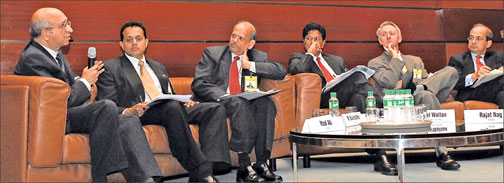Sri Lanka forerunner in Asia Pacific - Poverty reduction
Sri Lanka was hailed for being a fore runner in the key poverty ratio
indicators in the whole of Asia Pacific region at the recently concluded
Economic Forum on Inclusive Growth and Poverty Reduction in the New Asia
and Pacific in Manila, Philippines organized by the Asian Development
Bank(ADB).
|

Chief Economist ADB Dr. Ifzal Ali, Director Economic Affairs,
Government Peace Secretariat Rohantha Athukorala, Prime
Minister's Economic Council India Dr. Govinda Rao, Acting
Country Director Philippines World Bank Jehan Arulpragasam,
Harvard University Prof. Michael Walton and Managing Director
ADB Rajat Nag at the forum. |
Sri Lankan delegate the Director Economic Affairs for the Government
Peace Secretariat Rohantha Athukorala said the Sri Lankan economy has
experienced accelerated growth over the past two years despite adverse
shocks such as oil price hikes, the tsunamis and the escalation of
terrorism growth has averaged at 6.5% during the last 2 year and 4-5 per
cent historically.
The per capita income rising above US $ 1355 has made it a middle
income country. The higher economic growth has been accompanied by a
declining unemployment to 6.4 per cent which has come about through
successful structural and economic reforms implemented.
The private sector accounts for 85% of GDP and some blue clip
companies listed on the stock exchange are highly competitive,
profitable and financially strong and beginning to invest overseas.
Sri Lanka growth has outperformed countries in the region and has
been rated as single B and BB. On the key poverty ratios of those
earning a $1 and below coming down to just 2 percent and those earning
$2 and below to 32.8 percent augurs well for the country Athukorala
said.
The inflation observed through 2005 and early 2006 reversed due to
the passing down to consumers the high oil prices to consumers. The high
interest rate that has come into effect has become a drag to the
economy. However, the growth momentum has been sustained.
The GDP growth as at 1st quarter 2007 is 6.1%. But it is a challenge
seen around the world and how we manage our fiscal deficit to be kept at
seven percent and below will be the key challege Athukorala went on to
say.
ADB is currently discussing the concept of inclusive growth as its
mission statement for the next decade. Inclusive growth is different to
the pro-poor growth approach followed by the World Bank and other donors
as it claims to address also inequity and exclusion. Inclusive growth
means both creating economic opportunities through support to
sustainable growth in the Asia Pacific region.
The focus of the conference was if ADB should focus on trade,
infrastructure, new technologies and regional finance even though it may
not be ADB's comparative advantage or should ADB take a more balanced
approach of including pro-poor infrastructure, broad based financial
services, labour market relevant education, appropriate health
financing, social protection, addressing environmental poverty in the
region and supporting pro-poor growth potential areas in the region
through rural and urban development.
Athukorala said the challenge for Sri Lanka is that whist the GDP
contribution of the Western province dominates at 51 per cent whist the
rest of the regions economic growth lags on at 2-5 per cent for the last
five years highlights the urban rural gap.
Latest research reveals that the average per capita consumption grew
by 50 per cent for the richest consumption quintile but on 2 per cent
for the poorest quintile. The Gini Coefficient of per capita consumption
in Sri Lanka increased at an annual rate of 2 per cent, much higher than
for East Asian Comparator countries with the exempts of China.
If the line coefficient for consumption inequality remains unchanged
at the level of 2002 and growth continuous at the same rate as it did in
2004 and 2005, poverty will fall by more than 50% to 8.2% by 2015.
If however, consumption inequality increases - as it did in the last
10 years - poverty will fall to 14.8% from 26% in 1990/91 (World Bank,
2006) Further, urban poverty halved between 1990-91 and 2000, while
rural poverty declined by less than 5 percentage points, and poverty in
the Estates increased by about 50 per cent making this sector the
poorest in the country. |

